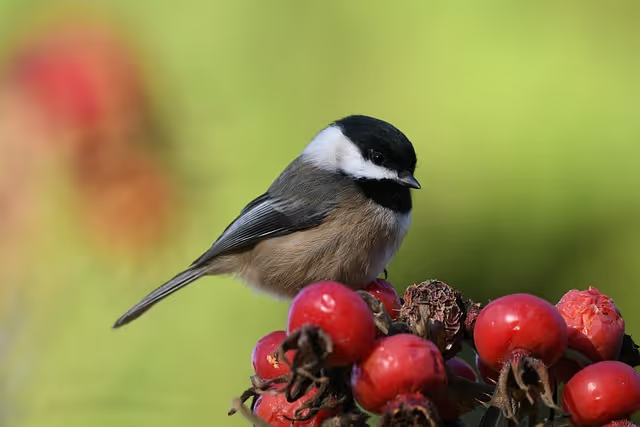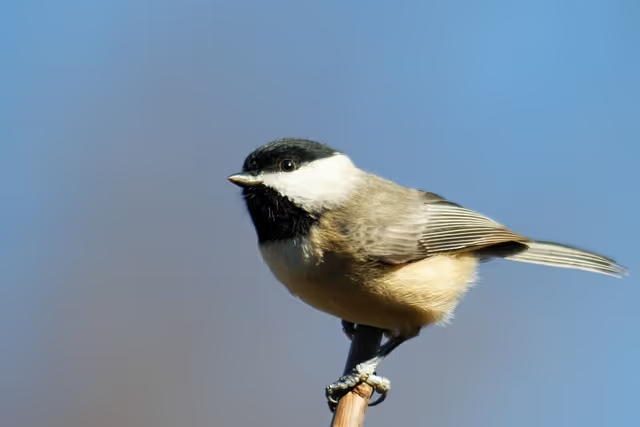The Black-Capped Chickadee


Introduction
The Black-capped Chickadee is a popular, attractive, and widespread bird that is adored by many people for its physical characteristics and inquisitive personality. It is often considered to be “cute” because of its small body and oversized head (1). This species loves to explore everything in its home territory, including humans (1). They are not shy about making their presence known. While they aren’t going to warm up to you in the way that a curious neighborhood or stray cat might, they will enjoy observing you from a safe distance. If you have a bird feeder, they will take full advantage of it and visit regularly (1).
Shape, Size, and Color
Black-capped Chickadees are small birds. However, they unique physical characteristics make them somewhat easy to spot. They have short necks and large heads, which give them a spherical body shape, which stands out from other birds (2). Black-capped Chickadees also have short bills with a medium thickness, along with long, narrow tails (2). Members of both sexes are 4.7 to 5.9 inches long (12 to 15 centimeters), weigh 0.3 to 0.5 ounces (9 to 14 grams), and have a wingspan of 6.3 to 8.3 inches (16 to 21 centimeters) (2).
As their name suggests, Black-capped Chickadees have Black “caps” (the upper portion of their head) (2). They also have black “bibs” (the area just below their beak) (2). Their cheeks are mostly white, but the backs take on a soft gray color. Their wing feathers are gray with white edging, while their flanks sport a shade of tan. Their bellies are white (2).
Range
The Black-capped Chickadee (scientific name: Poecile atricapillus) can be found across most of the Northern and Central United States, as well as across the majority of Canada (3). The species’ range spreads from coast to coast, extending from the cold waters of Western Alaska to the not-quite-as-cold waters of Northern New England. Their range includes the vast majority of the Pacific Northwest (the only exception is a small sliver of South-Central Oregon and Southeastern Oregon near the California and Nevada borders) most of the Great Plains, all of the Great Lakes, nearly all of the Rocky Mountains, and most of the Appalachian Mountains (3). Black-capped Chickadees are not migratory birds. They occupy all parts of their range year-round (3).

Habitat
Black-capped Chickadees make their homes in mixed and deciduous woods, shade trees, groves, and willow thickets. They are most commonly seen in open woods and at the edges of forests, especially where alder and birch trees grow (3). Here in the Pacific Northwest, where the Black-capped Chickadee is not the only species of chickadee around, they often find themselves being limited to deciduous groves (3). They will take up residence in suburban areas, so long as suitable nest sites are available (3).
Diet and Feeding Behavior
Black-capped Chickadees generally have to forage for their food. They do this by “hopping” on twigs and branches and taking food from the surface (3). They often hang upside down to reach the undersides of branches (3). Their diet varies seasonally, but usually consists of a combination of seeds, berries, insects (insect eggs are a particular favorite), caterpillars, spiders, and snails. They will also eat the fat of dead animals (3). Sometimes, Black-capped Chickadees will take food while they are hovering, and may even fly out to grab insects in mid-air (3).
Black-capped Chickadees will often store up food to eat later, much like squirrels do. They stash every item of food they store, whether it be a seed or an insect, in its own unique location (1). Black-capped Chickadees have very good memories, and can remember thousands of locations (1), which enables them to store food this way and avoid the risk of storing all of their food in just one place and having another animal find that place and eat the entire stash.
As we mentioned earlier, Black-capped Chickadees also love bird feeders, and will visit them readily (1). However, don’t expect them to stick around for very long. They normally just pop in to grab some food, and then fly off to eat it somewhere else (2). Their favorite foods from bird feeders are seeds and suet (3).
Nesting
Black-capped Chickadees typically form pairs during the fall. They stay together through the winter as part of larger flocks (3). The flocks go their separate ways in late winter, with formed pairs setting out to find nesting sites (3).
The ideal nesting site for a Black-capped Chickadee is inside of a hole in a tree, with enlargements of small, natural cavities in rotten wood being particular favorites (3). When a cavity needs to be enlarged to accommodate the nest, both members of the pair will work together to complete it (3). Once the enlargement is done, the female assumes sole responsibility for the construction of the nest. The nest is built with a foundation of moss, and is lined with softer material, such as hair from other animals (3).
If a natural cavity isn’t available, old woodpecker holes and nesting boxes will be sought after for nesting sites (3). Once a site is chosen, the female will build the nest herself, following the same methods she would use if she was building it in a natural cavity (3).

Image by Bernell MacDonald from Pixabay
Eggs and the Young
Black-capped Chickadees typically lay anywhere from six to eggs. The eggs are white overall, with small dots of reddish brown located around the larger end of the eggs (3). The incubation process is handled exclusively by the female, and runs for approximately two weeks. The male often brings food to the female during the incubation period (3). However, in the event that the female has to leave the nest to find food for herself, she covers the eggs with nesting material in an effort to hide them from predators (3). Once the young hatch, they only remain in the nest for about sixteen days. The female remains with them for the majority of that time, with the male bringing food for everyone (3). As the sixteen days start drawing to a close, both parents will take part in delivering food to the young (3). The young become fully independent at around five weeks of age (4).
Calls and Dominance Hierarchies
The most common call that a Black-capped Chickadee uses is a two or three note high-pitched whistle. The whistle will sound like “fee-bee” (4). The whistles don’t feature any added buzzing or warbling, which makes them very clear (4). When they are alarmed by something, Black-capped Chickadees will sound a series of high-pictured twitters, with the whistle sounding like “dee-dee-dee” (4).
Black-capped Chickadees have dominance hierarchies. These are usually based on the age and sex of the bird. Generally, older birds have more dominance than younger birds (4). Male birds also tend to be dominant to females (4). When a bird with less dominance gets too close to a bird with more dominance, it may be met with a call that sounds like a “gargle” (4). This call is also used between members of a formed pair (4).
References
© Ian Caldwell, September 2023
Touch whale bones, examine shipwreck artifacts and connect with the coast's living history.

Support our mission, get involved in educational programs, or contribute through donations and volunteering.